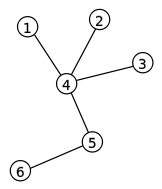Prüfer sequence
In combinatorial mathematics, the Prüfer sequence (also Prüfer code or Prüfer numbers) of a labeled tree is a unique sequence associated with the tree. The sequence for a tree on n vertices has length n − 2, and can be generated by a simple iterative algorithm. Prüfer sequences were first used by Heinz Prüfer to prove Cayley's formula in 1918.[1]
Algorithm to convert a tree into a Prüfer sequence
[edit]One can generate a labeled tree's Prüfer sequence by iteratively removing vertices from the tree until only two vertices remain. Specifically, consider a labeled tree T with vertices {1, 2, ..., n}. At step i, remove the leaf with the smallest label and set the ith element of the Prüfer sequence to be the label of this leaf's neighbour.
The Prüfer sequence of a labeled tree is unique and has length n − 2.
Both coding and decoding can be reduced to integer radix sorting and parallelized.[2]
Example
[edit]
Consider the above algorithm run on the tree shown to the right. Initially, vertex 1 is the leaf with the smallest label, so it is removed first and 4 is put in the Prüfer sequence. Vertices 2 and 3 are removed next, so 4 is added twice more. Vertex 4 is now a leaf and has the smallest label, so it is removed and we append 5 to the sequence. We are left with only two vertices, so we stop. The tree's sequence is {4,4,4,5}.
Algorithm to convert a Prüfer sequence into a tree
[edit]Let {a[1], a[2], ..., a[n]} be a Prüfer sequence:
The tree will have n+2 nodes, numbered from 1 to n+2.
For each node set its degree to the number of times it appears in the sequence plus 1.
For instance, in pseudo-code:
Convert-Prüfer-to-Tree(a) 1 n ← length[a] 2 T ← a graph with n + 2 isolated nodes, numbered 1 to n + 2 3 degree ← an array of integers 4 for each node i in T do 5 degree[i] ← 1 6 for each value i in a do 7 degree[i] ← degree[i] + 1
Next, for each number in the sequence a[i], find the first (lowest-numbered) node, j, with degree equal to 1, add the edge (j, a[i]) to the tree, and decrement the degrees of j and a[i]. In pseudo-code:
8 for each value i in a do 9 for each node j in T do 10 if degree[j] = 1 then 11 Insert edge[i, j] into T 12 degree[i] ← degree[i] - 1 13 degree[j] ← degree[j] - 1 14 break
At the end of this loop two nodes with degree 1 will remain (call them u, v). Lastly, add the edge (u,v) to the tree.[3]
15 u ← v ← 0 16 for each node i in T 17 if degree[i] = 1 then 18 if u = 0 then 19 u ← i 20 else 21 v ← i 22 break 23 Insert edge[u, v] into T 24 degree[u] ← degree[u] - 1 25 degree[v] ← degree[v] - 1 26 return T
Cayley's formula
[edit]The Prüfer sequence of a labeled tree on n vertices is a unique sequence of length n − 2 on the labels 1 to n. For a given sequence S of length n − 2 on the labels 1 to n, there is a unique labeled tree whose Prüfer sequence is S.
The immediate consequence is that Prüfer sequences provide a bijection between the set of labeled trees on n vertices and the set of sequences of length n − 2 on the labels 1 to n. The latter set has size nn−2, so the existence of this bijection proves Cayley's formula, i.e. that there are nn−2 labeled trees on n vertices.
- Cayley's formula can be strengthened to prove the following claim:
- The number of spanning trees in a complete graph with a degree specified for each vertex is equal to the multinomial coefficient
- The proof follows by observing that in the Prüfer sequence number appears exactly times.
- Cayley's formula can be generalized: a labeled tree is in fact a spanning tree of the labeled complete graph. By placing restrictions on the enumerated Prüfer sequences, similar methods can give the number of spanning trees of a complete bipartite graph. If G is the complete bipartite graph with vertices 1 to n1 in one partition and vertices n1 + 1 to n in the other partition, the number of labeled spanning trees of G is , where n2 = n − n1.
- Generating uniformly distributed random Prüfer sequences and converting them into the corresponding trees is a straightforward method of generating uniformly distributed random labelled trees.
References
[edit]- ^ Prüfer, H. (1918). "Neuer Beweis eines Satzes über Permutationen". Arch. Math. Phys. 27: 742–744.
- ^ Caminiti, S., Finocchi, I., Petreschi, R. (2007). "On coding labeled trees". Theoretical Computer Science. 382 (2): 97–108. doi:10.1016/j.tcs.2007.03.009.
{{cite journal}}: CS1 maint: multiple names: authors list (link) - ^ Jens Gottlieb; Bryant A. Julstrom; Günther R. Raidl; Franz Rothlauf. (2001). "Prüfer numbers: A poor representation of spanning trees for evolutionary search" (PDF). Proceedings of the Genetic and Evolutionary Computation Conference (GECCO-2001): 343–350. Archived from the original (PDF) on 2006-09-26.
- ^ Kajimoto, H. (2003). "An Extension of the Prüfer Code and Assembly of Connected Graphs from Their Blocks". Graphs and Combinatorics. 19 (2): 231–239. doi:10.1007/s00373-002-0499-3. S2CID 22970936.
External links
[edit]- Prüfer code – from MathWorld






